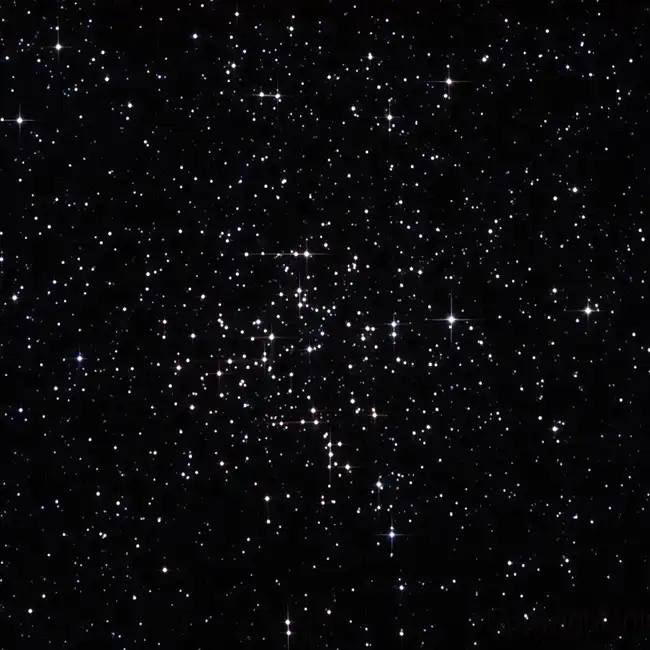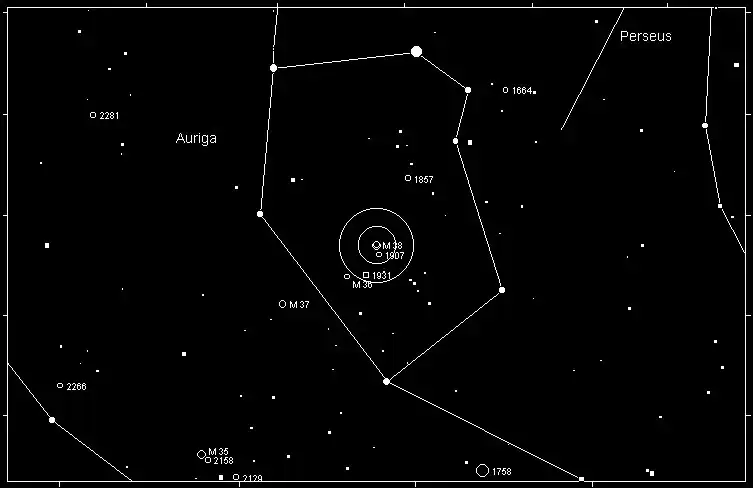Messier 38 (M38), also known as the Starfish Cluster, is an open star cluster located in the constellation Auriga. This beautiful cluster is composed of approximately 100 stars spread out over a region about 25 light-years in diameter. The stars in M38 are relatively young, with an estimated age of around 220 million years. The cluster's name, the Starfish Cluster, comes from the distinctive pattern of its brightest stars, which resemble the shape of a starfish when viewed through a telescope.
Magnitude
M38 has an apparent magnitude of 7.4, making it faintly visible to the naked eye under extremely dark skies. However, it is best observed using binoculars or a small telescope, where it reveals its rich collection of stars and its starfish-like structure. The cluster's brightest stars shine at around magnitude 9, adding to the cluster's visual appeal when observed through a telescope.

Season of Prominence
Messier 38 is most prominent in the night sky during the winter months for observers in the Northern Hemisphere. It is best observed from late autumn through early spring when the constellation Auriga is high in the sky during the evening hours.
Constellation and Location
M38 is located in the constellation Auriga, the Charioteer, which is known for its many open star clusters. Auriga is one of the 88 modern constellations and is easily recognizable due to its pentagon shape and its bright star, Capella. M38 is situated in the western part of Auriga, near two other prominent open clusters, Messier 36 and Messier 37.
How to Find M38
To locate Messier 38, start by finding the bright star Capella, which is the sixth-brightest star in the night sky and the brightest star in Auriga. From Capella, trace a line southwestward to the star Iota Aurigae. M38 lies about halfway between Iota Aurigae and the star Theta Aurigae. The cluster can be found just to the west of this line.
When using a telescope, start with a low-power eyepiece to locate the cluster. M38 will appear as a faint, hazy patch of light. Once you've found it, switch to a higher magnification to resolve individual stars and appreciate the starfish-like pattern of its brightest members.

History
Messier 38 was discovered by the Italian astronomer Giovanni Battista Hodierna before 1654, making it one of the earlier known open clusters. However, it was independently rediscovered by the French astronomer Guillaume Le Gentil in 1749. It was Charles Messier who added it to his famous catalog of nebulae and star clusters in 1764.
The Messier catalog, compiled by Charles Messier, is a list of astronomical objects that could be mistaken for comets. While searching for comets, Messier kept track of these objects so that they would not be confused with his primary targets. Messier 38, with its distinctive shape and location in Auriga, became one of the notable entries in this catalog.
Conclusion
Messier 38 is a fascinating open star cluster that offers amateur astronomers a chance to explore the wonders of the winter sky. Its unique starfish shape, relatively bright stars, and historical significance make it a rewarding target for observation. Whether you're a seasoned stargazer or a beginner, M38 is a must-see object during the winter months, providing a glimpse into the beauty of the universe
